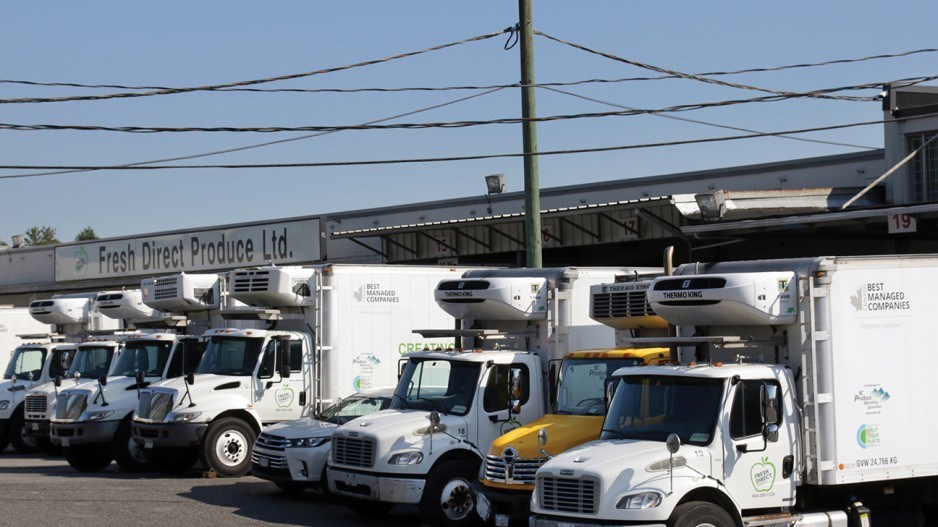Growing port traffic and the need for more housing is raising pressure on Vancouver’s remaining industrial lands.
Removal of the Georgia and Dunsmuir viaducts – industrial-era infrastructure that the city’s former co-director of planning, Larry Beasley, has called “a remnant of a history we don’t actually like” – will create space for housing and other uses. Yet it will also require realignment of the key Prior-Venables arterial that provides access to downtown and port properties along Burrard Inlet.
This could spell the end of the road for the cluster of food distribution businesses along Malkin Avenue, an area colloquially known as Produce Row that’s been on the False Creek flats for nearly 60 years. A legacy of the city’s industrial past, today they’re part of the city’s multifaceted urban fabric.
“It’s very important to both protect and enhance that cluster of food distribution businesses along Malkin Avenue,” said Pietra Basilij, a sustainable community development specialist with the Vancouver Economic Commission who recently wrote a report on the state of the city’s industrial lands. “[But] there’s a really big transportation decision to be made there, mainly to be driven by the port.”
While other distribution businesses have left for surrounding municipalities, Produce Row continues to thrive thanks to its vital role in supplying the city with fresh produce from local farms and around the world. Vancouver touts food security in its vision to be the greenest city by 2020, and Produce Row is a key element in the city’s ability to feed itself.
“[Most] industrial uses that have bigger infrastructure requirements, bigger transportation requirements in particular, or bigger facilities have moved elsewhere throughout the region, and that’s not necessarily a bad thing,” Basilij said. “In the case of Malkin Avenue, it’s a different scenario. Breaking up that cluster or moving that set of businesses outside the region would have huge impacts on the, say, the cost of food. They’re serving most of the local independent grocers and the restaurants in town.”
BC Trucking Association president and CEO Dave Earle agrees.
“It creates huge efficiencies,” Earle said. “And if it changes, and they have to move, I can absolutely promise you, everything gets more expensive.”
While the city announced a panel earlier this year to address the issue, it remains shrouded in secrecy. Writing to Vancouver council at the end of July, Earle expressed “significant concern” at “the lack of consultation regarding the panel” and the timeline for a solution.
“The whole decision-making process on that, to the best of my knowledge is kind of at an impasse,” Basilij said. “It’s stalled out, probably because it’s an election year.”
The situation on Malkin Avenue could be paralleled in an initiative the city approved in July – a new greenway through East Vancouver from Main Street to Boundary Road. Details are scant, but the proposed routes include Powell Street, which runs adjacent to the port and is home to several light industrial and manufacturing businesses. While the greenway will likely use existing rights of way, existing businesses could be significantly affected.
The cluster of craft breweries that have done much to renew traffic to other industrial areas across the region may benefit from a new “active transportation corridor” geared to cyclists and pedestrians, but businesses receiving deliveries by truck may be inconvenienced.
Or not.
A greenway could benefit industrial businesses by reducing conflicts on the street, Basilij said.
“One of the biggest points of conflict right now between active transportation uses – bicyclists and pedestrians – and trucks in industrial areas is the fact that they are literally using the same roads,” she said.
It’s a common issue on Malkin Avenue, where some businesses say 60% of staff walk or cycle to work.
“If you put in a greenway and it’s planned and designed really well, you can start to reorient some of that pedestrian and bicycle traffic into a condensed or confined area so that it’s not spread throughout, where you’re doing some of your bigger trucking operations,” Basilij said.
Patricia Barnes, executive director of the Hastings North BIA, said a greenway could help take the pressure off Powell, which she said was originally a residential street before industry took over.
“It wasn’t built to take truck traffic, and the trucks got bigger,” she said.
But establishing a greenway isn’t as simple as saying, “Bikes can go here,” she said. Similarly, the realignment of Prior-Venables isn’t as simple as saying, “Trucks can go there.”
“A lot of this conflict will have to play out in the actual design phase,” Basilij said. “If the idea is to create access for businesses and residents living in the area, it will still need to be done within the framework of ensuring that it fits within the industrial function that’s down in that part of the city.”




